Glossary
Jump to navigation
Jump to search
A B C D E F G H I J K L M N O P Q R S T U V W X Y Z 0-9
A
Abbey
- A special tile which can only be placed in a hole in the playing field, but can be placed irrespective of the contents of adjacent tiles. A meeple (follower) deployed to an abbey is a monk. The abbey is scored in the same way as a completed monastery (cloister). An abbey may challenge or be challenged by a shrine. This tile is part of
 Abbey & Mayor.
Abbey & Mayor. - Applies to C1 and C2
Abbot (figure)

- A type of meeple that can only be placed on monasteries or gardens. This meeple comes with the
 base game and is part of the mini-expansion
base game and is part of the mini-expansion  The Abbot.
The Abbot. - Applies to C2/C3 only
Abbot (special monastery rules)
- An alternate type of meeple (follower) placement that can used on a special monastery. The meeple (follower) is placed on its side to indicate that it will not be scored until the end of the game. It will score points for all tiles in the rows and columns starting from the monastery. This alternate placement is part of the mini-expansions in the special monastery series including Monasteries in Germany (CI and CII), Monasteries in the Netherlands & Belgium (CI only), Japanese Buildings (CII only):
- CII: Monasteries
- CI: Monasteries (1st edition)
- Applies to CI and CII
Active player
- The player whose turn it currently is. Even when other players carry out actions during a player’s turn (such as parachuting followers in, or taking part in a round of bidding), they are not considered to be active.
B
Barn

- Included in Abbey & Mayor and Abbey and the Mayor (1st edition), the barn is placed on the intersection of four field segments. On placement, all farmers on that farm are removed immediately and score 3 points per completed city touching the farm. This score may be adjusted by a pig, a pig-herd, or a Cathar /siege tile. Any farmers subsequently joining this farm score 1 point (plus adjustments) for every completed city and are then removed. During final scoring, every completed city on the farm with the barn scores 4 points (plus adjustments).
- Applies to C1 and C2.
Bazaar


- This landscape element appears on tiles from expansion: Bridges, Castles and Bazaars and Bridges, Castles and Bazaars (1st edition). The placement of a tile with a bazaar opens a round of bidding.
- Applies to C1 and C2.
Big Box
- A Carcassonne compilation, containing multiple major and/or minor expansions. There have been several Big Boxes over the years, for all the current Big Boxes see: Big Boxes.
Big Meeple

- A type of meeple that has the strength of two. That is, although the big meeple is still only a single meeple, it counts as two for the purpose of calculating the majority. In all other ways the big meeple is identical to the normal meeple. This meeple comes with the expansion: Inns and Cathedrals and Inns and Cathedrals (1st edition).
- Applies to C1 and C2/C3.
Big Pig

- Included in The Wheel of Fortune, the big pig is an oversized pink pig which is placed on the Wheel, facing clockwise. Whenever a tile with a Wheel icon is drawn, the pig is moved around the wheel the same number of sectors as shown in the icon. Landing in a sector triggers an event, and any meeple stood on a crown space in that sector are scored.
- Applies to C1 only.
Bridge (landscape)

- First included in Traders and Builders (1st edition), a bridge is not a crossing—the road segments run continuously over or under each other. However, in the example shown, the farm segments do not continue under the bridge.

- Similarly, a city may bridge another city, as in the example shown. In this case there are also two separate cities.
- Applies to C1 and C2.
Bridge (wooden piece)
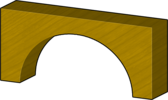
- In Bridges, Castles and Bazaars and Bridges, Castles and Bazaars (1st edition), a bridge piece may be placed in addition to a tile and meeple. It must be placed on farm segments, either on the tile being placed or on one which touches it horizontally or vertically. Such a bridge continues a road, over any features underneath it, and is scored in the same way as a normal road segment.
- Applies to C1 and C2.
Builder

- A special figure included in Traders and Builders and Traders and Builders (1st edition), the builder is dependent on a meeple for placement. It may be placed on a road or in a city; should the feature be extended during the player’s next turn, then the player may take a double turn.
- Applies to C1 and C2/C3.
C
Cathedral


- This landscape element appears on tiles from the expansions: Inns and Cathedrals and Inns and Cathedrals (1st edition). A city containing a cathedral scores 3 points for every tile and Coat Of Arms when it is completed (instead of the usual 2). However, if it remains incomplete at the end of the game, the city scores 0 points.
- Applies to C1 and C2/C3.
City
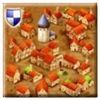
- One of the four basic types of features. A meeple deployed to a city is called a knight. When a city is completed, every tile and coat of arms scores 2 points. At the end of the game, every incomplete city scores 1 point for every tile and coat of arms.
Cloister


- One of the four basic types of features. A meeple deployed to a cloister is called a monk. When the eight adjacent tiles (horizontal, vertical, and diagonal) have been placed the cloister is complete and scores 9 points. At the end of the game, an incomplete cloister scores 1 point for every neighboring tile (including the cloister itself). A cloister may challenge or be challenged by a shrine.
Cloth


- This cloth token is found in Traders and Builders, cloth is one of the three types of trade goods. There are five corresponding tokens.
- Applies to C1 and C2/C3.
Coat of Arms

- Used in C2 for the blue and white shields on some city segments. Also known as "Pennants" (in C1) and "Shields" (common usage).
- Applies to C2/C3 only.
D
Deployement
- Moving a meeple from the supply to occupy a feature. Also called ‘moving the wood’.
Dragon

- Included in The Princess & the Dragon, whenever a volcano tile is placed, the dragon is moved to it immediately. Whenever a tile with a dragon symbol is placed the dragon moves—according to HiG, this movement occurs after deployment but before scoring, while the RGG rules state that the dragon moves after scoring. The dragon moves 6 tiles either horizontally or vertically, each player taking it in turns to move the dragon one tile at a time. If the dragon moves onto a tile occupied by a meeple, builder or pig, the figure is ‘eaten’ and returned to its owner, along with any dependent figures (such a builder or pig). The dragon may not move onto the same tile twice in a turn, nor a tile occupied by the fairy or one of the twelve tiles of the City of Carcassonne. If the dragon is unable to continue moving according to the rules above, it has reached a dead end and its current movement phase is over.
- Applies to C1 and C2.
Dragon feature
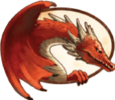

- Included in The Princess & the Dragon, whenever a tile with a dragon feature is placed the dragon moves.
- Applies to C1 and C2.
F
Farmhouse

- This landscape element appears on tiles in the base game and many expansions in C2, and is used for additional scoring when using The Markets of Leipzig and The Tollkeepers, or scoring less points when using Peasant Uprising tile in The Land Surveyors.
- Applies to C2/C3 only.
Festival
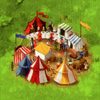
- This landscape element only appears on tiles in The Festival.
- Applies to C2/C3 only.
Ferry

- A wooden piece that can be used to connect two road segments over a lake in The Ferries mini-expansion.
- Applies to C1 and C2/C3.
Field
Flying Machine


- This landscape element appears on tiles from the mini-expansion The Flier and The Flier (1st edition) which allows placement of a meeple onto a different tile with the roll of a die.
- Applies to C1 and C2/C3.
Follower
- Used to refer in C1 to the standard follower included in the basic game. In C2 they are now called a meeple.
Fork
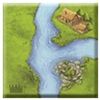
- A tile from The River II which the starting player should place immediately after the spring tile. Subsequent river tiles may be placed on either branch.
- Applies to C1 and C2.
G
Garden

- This landscape element appears on tiles in the base game and many expansions in C2, and is used for scoring when playing with The Abbot or The Tollkeepers.
- Applies to C2/C3 only.
Goldmine
- A symbol found in The Goldmines mini-expansion that allows placement of a gold piece onto that tile and an adjacent tile.
Gold pieces

- Wooden tokens found in The Goldmines mini-expansion which are collected by players and scored at the end of the game. The more gold pieces collected, the more each is worth.
Grain


- This grain token is found in Traders and Builders, grain is one of the three types of trade goods. There are six corresponding tokens.
- Applies to C1 and C2/C3.
H
Highwaymen

This landscape element shows highwaymen hiding amongst trees - several variations exist - and appears next to a road on tiles in the base game and many expansions in C2. It is used for scoring when playing with The Tollkeepers.- Applies to C2/C3 only.
Hills
This feature appears on tiles from the expansion Hills & Sheep which changes the majority of features.
Applies to C1 and C2.
House rule
- Any unofficial rule used in the game.
I
Inn

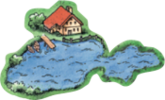
- These landscape elements (C2 inn, C1 inn) appear on tiles in Inns and Cathedrals, Count, King and Robber and Bridges, Castles and Bazaars. They are used for scoring when playing with the rules for C2: Inns and Cathedrals and C1: Inns and Cathedrals (1st edition).
- Note: River II, included in Count, King & Robber, has a tile with an inn. This inn has a yellowish roof in C2 but it is pictured as a regular inn in C1.

K
Klaus-Jürgen Wrede
- The author of Carcassonne.
Knight
- A meeple deployed to a city.
M
Magic portal
This feature appears on tiles from the expansion ![]() The Princess & the Dragon which allows to move meeples to already placed tiles.
The Princess & the Dragon which allows to move meeples to already placed tiles.
- Applies to C1 and C2.
Monastery
- Cloister.
Monk
- A meeple deployed to a cloister.
P
Pennants

- This icon, which can be identified by his blue and white colours, can be found on some city segments on C1 tiles. Also known as "Coat of Arms" (in C2) and "Shields" (common usage).
- Applies to C1 only.
Princess
This feature appears on tiles from the expansion Princess & Dragon which allows to remove knights of a city.
- Applies to C1 and C2.
R
Road
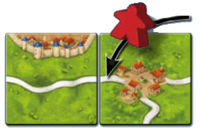
- One of the four basic types of features. A meeple deployed to a road is called a thief. A completed road scores 1 point for each tile on which it is visible; during final scoring, incomplete roads also score 1 point per tile.
S
Segment
- A segment is a section of a feature on a tile.
Shed



These landscape elements (Cowshed, Donkey stable and Pigsty) appear on tiles in the base game and many expansions in C2, and are used for scoring when playing with The Markets of Leipzig or The Tollkeepers.- Applies to C2/C3 only.
Shield


- The blue and white shields on some city segments. Also known as "Pennants" (in C1) and "Coat of Arms" (C2).
Spring
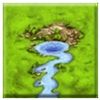
- The starting tile of the river.
Starting player
- According to The River II, the youngest player begins the game by placing the fork. According to the HiG rules for the basic game, the youngest player decides who will begin. According to some RGG rules, the players decide among themselves who will be the starting player, using any method they choose. It’s up to you.
Starting tile


- The tile with the dark back in the basic game. If other starting expansions are used, then this tile will be discarded.
T
Trade goods
- There are three types of trade goods: cloth, grain and wine. Tokens for trade goods are awarded to the player who places the tile which completes a city containing their symbols, regardless of whether the player is otherwise involved in scoring. At the end of the game, the player with the majority in a trade good receives 10 points.
V
Volcano


- The volcano is introduced in
 The Princess & the Dragon. When a tile with the volcano is placed, then Dragon is moved to this tile.
The Princess & the Dragon. When a tile with the volcano is placed, then Dragon is moved to this tile. - Applies to C1 and C2.
W
Water Tower
Wine


- This wine token is introduced in
 Traders & Builders, it represent wine as one of the three types of trade goods. There are nine corresponding tokens.
Traders & Builders, it represent wine as one of the three types of trade goods. There are nine corresponding tokens. - Applies to C1 and C2/C3.









